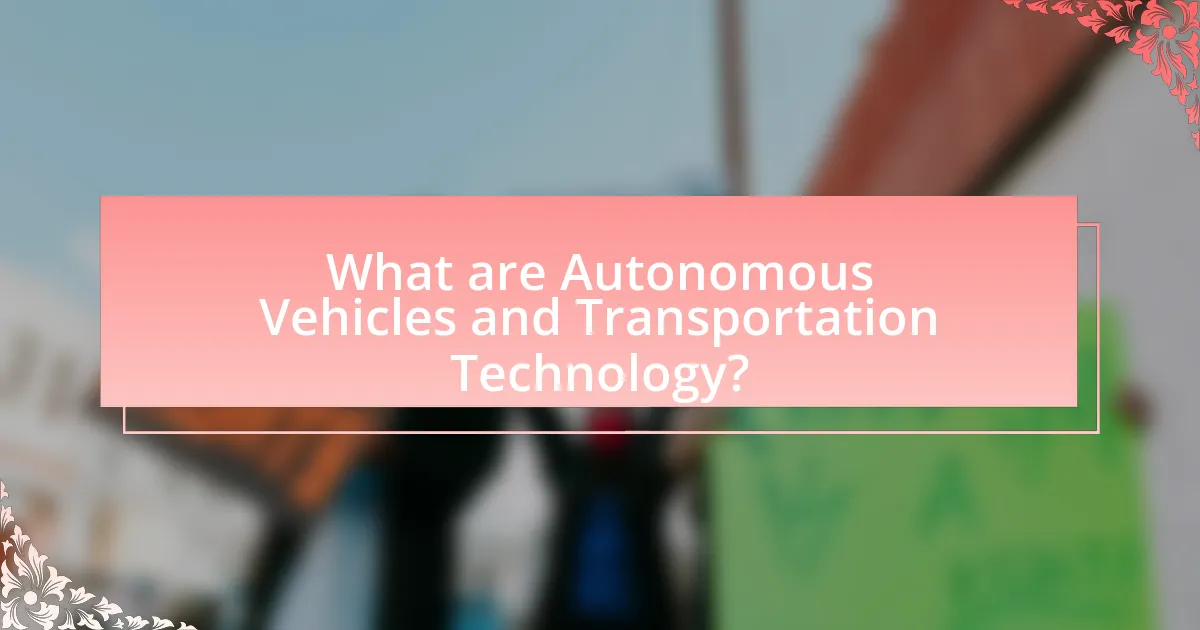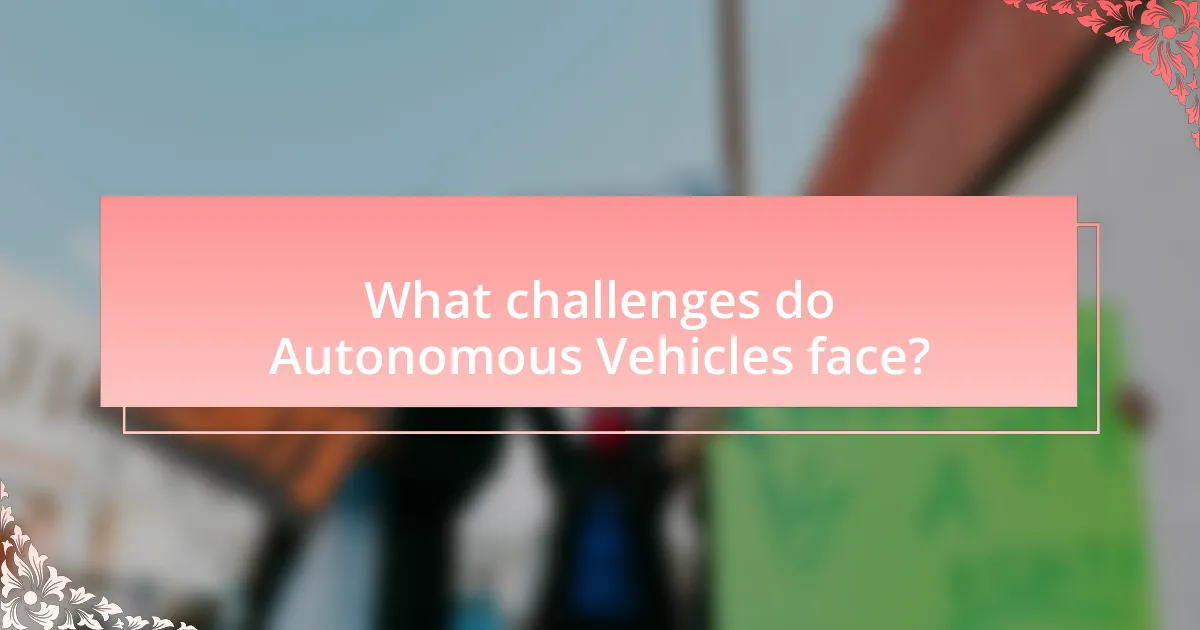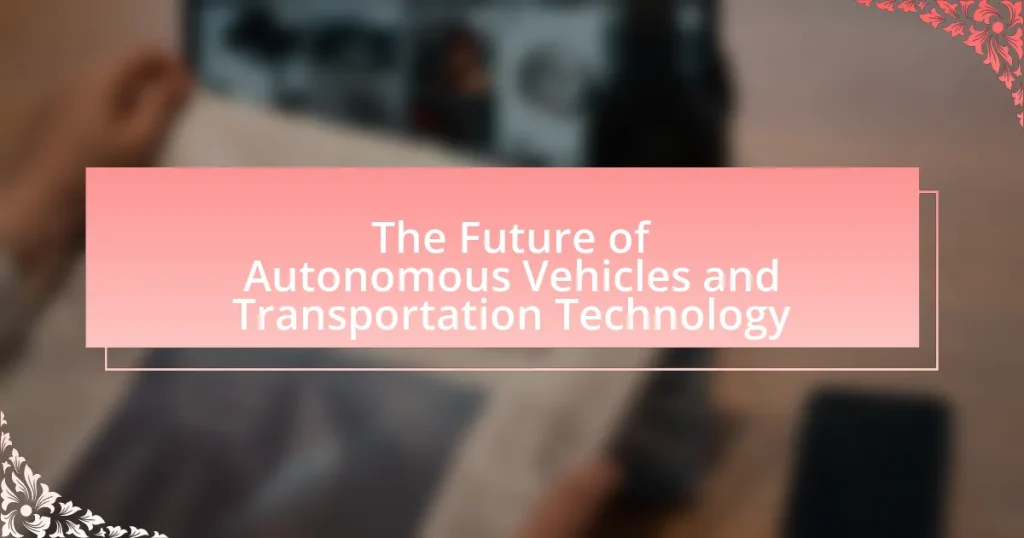Autonomous vehicles are self-driving cars that utilize advanced technologies such as sensors, cameras, and artificial intelligence to navigate without human intervention. This article explores the functioning of autonomous vehicles, the technologies that enable their operation, and the broader context of transportation technology, including smart traffic management and connected infrastructure. It discusses the potential benefits of autonomous vehicles, such as increased safety and reduced traffic congestion, while also addressing the challenges they face, including regulatory hurdles and public acceptance. Additionally, the article examines the role of data in modern transportation systems, the economic impacts of widespread adoption, and the future advancements in AI and infrastructure necessary for successful integration.

What are Autonomous Vehicles and Transportation Technology?
Autonomous vehicles are self-driving cars equipped with technology that allows them to navigate and operate without human intervention. This technology includes sensors, cameras, and artificial intelligence algorithms that enable the vehicle to perceive its environment, make decisions, and control its movements. Transportation technology encompasses a broader range of innovations aimed at improving the efficiency, safety, and sustainability of transportation systems, including autonomous vehicles, smart traffic management systems, and connected infrastructure. The development of autonomous vehicles is supported by advancements in machine learning and robotics, which have led to significant progress in their reliability and safety, as evidenced by extensive testing and pilot programs conducted by companies like Waymo and Tesla.
How do Autonomous Vehicles function?
Autonomous vehicles function by utilizing a combination of sensors, cameras, artificial intelligence, and machine learning algorithms to navigate and operate without human intervention. These vehicles gather data from their surroundings through LIDAR, radar, and visual sensors, which allow them to detect obstacles, lane markings, and traffic signals. The onboard AI processes this data in real-time to make driving decisions, such as acceleration, braking, and steering, ensuring safe navigation. According to a report by the National Highway Traffic Safety Administration, autonomous vehicles have the potential to reduce traffic accidents significantly, as they can react faster than human drivers and eliminate errors caused by fatigue or distraction.
What technologies enable the operation of Autonomous Vehicles?
Autonomous vehicles operate through a combination of technologies including sensors, artificial intelligence, machine learning, and connectivity systems. Sensors such as LiDAR, radar, and cameras provide real-time data about the vehicle’s surroundings, enabling it to detect obstacles, lane markings, and traffic signals. Artificial intelligence processes this data to make driving decisions, while machine learning algorithms improve the vehicle’s performance over time by learning from past experiences. Connectivity systems, including V2X (vehicle-to-everything) communication, allow vehicles to interact with other vehicles and infrastructure, enhancing safety and efficiency. These technologies collectively ensure that autonomous vehicles can navigate complex environments safely and effectively.
How do sensors and software interact in Autonomous Vehicles?
Sensors and software in autonomous vehicles interact by enabling real-time data collection and processing for navigation and decision-making. Sensors, such as LiDAR, cameras, and radar, gather environmental data, which the software analyzes to interpret surroundings, detect obstacles, and make driving decisions. For instance, a study by the National Highway Traffic Safety Administration indicates that sensor data is crucial for achieving Level 4 and Level 5 automation, where vehicles can operate without human intervention. This interaction allows autonomous vehicles to adapt to dynamic environments, ensuring safety and efficiency in transportation.
What are the key components of Transportation Technology?
The key components of Transportation Technology include vehicles, infrastructure, communication systems, and data analytics. Vehicles encompass various modes such as cars, trucks, trains, and drones, which are designed for efficient movement of people and goods. Infrastructure refers to the physical components like roads, bridges, and railways that support transportation systems. Communication systems involve technologies that enable real-time data exchange between vehicles and infrastructure, enhancing safety and efficiency. Data analytics plays a crucial role in optimizing routes, predicting traffic patterns, and improving overall system performance. These components collectively contribute to advancements in transportation, particularly in the context of autonomous vehicles, which rely heavily on integrated technology for navigation and operation.
How do different modes of transportation integrate with technology?
Different modes of transportation integrate with technology through the use of advanced systems such as GPS, IoT, and AI. For instance, public transit systems utilize GPS for real-time tracking, allowing passengers to receive updates on arrival times, which enhances efficiency and user experience. Additionally, ride-sharing services like Uber and Lyft leverage mobile applications that connect drivers and passengers, optimizing routes through algorithms that analyze traffic data. Furthermore, autonomous vehicles employ AI and machine learning to navigate and make decisions based on real-time environmental data, significantly improving safety and reducing human error. The integration of these technologies not only streamlines operations but also contributes to the development of smart cities, where transportation systems are interconnected and data-driven.
What role does data play in modern transportation systems?
Data is essential in modern transportation systems as it enables real-time decision-making, enhances safety, and optimizes efficiency. Transportation networks utilize data from various sources, including GPS, sensors, and traffic cameras, to monitor conditions and manage traffic flow. For instance, cities employing smart traffic management systems can reduce congestion by up to 30% through data-driven traffic signal adjustments. Additionally, data analytics plays a crucial role in predictive maintenance for vehicles, reducing downtime and improving reliability. The integration of data in autonomous vehicles allows for advanced navigation and obstacle detection, significantly increasing safety and operational efficiency.
What are the potential benefits of Autonomous Vehicles?
Autonomous vehicles offer several potential benefits, including increased safety, reduced traffic congestion, and enhanced mobility for individuals unable to drive. Studies indicate that autonomous vehicles could significantly decrease traffic accidents, with estimates suggesting that up to 94% of crashes are caused by human error. Furthermore, these vehicles can optimize driving patterns, leading to smoother traffic flow and reduced congestion, which can save time and fuel. Additionally, autonomous vehicles can provide greater accessibility for the elderly and disabled, allowing them to travel independently.
How can Autonomous Vehicles improve road safety?
Autonomous vehicles can improve road safety by significantly reducing human error, which is responsible for approximately 94% of traffic accidents. These vehicles utilize advanced sensors, machine learning algorithms, and real-time data processing to detect and respond to their environment more effectively than human drivers. For instance, studies have shown that the implementation of autonomous driving technology could potentially decrease traffic fatalities by up to 90% by eliminating distractions, fatigue, and impaired driving. Additionally, autonomous vehicles can communicate with each other and infrastructure, enhancing situational awareness and enabling coordinated responses to potential hazards, further contributing to safer road conditions.
What economic impacts can be expected from widespread adoption?
Widespread adoption of autonomous vehicles is expected to significantly reduce transportation costs and increase productivity. The implementation of autonomous technology can lower operational expenses by up to 30% due to reduced labor costs and improved fuel efficiency. Additionally, a study by the Eno Center for Transportation estimates that autonomous vehicles could generate $1.3 trillion in economic benefits annually through increased safety, reduced congestion, and enhanced mobility options. These economic impacts highlight the potential for transformative changes in various sectors, including logistics, public transportation, and urban planning.

What challenges do Autonomous Vehicles face?
Autonomous vehicles face significant challenges including technological limitations, regulatory hurdles, and public acceptance issues. Technological limitations involve the need for advanced sensors and algorithms to navigate complex environments safely, as evidenced by incidents where vehicles misinterpret road conditions or obstacles. Regulatory hurdles arise from the lack of standardized laws governing autonomous vehicle operation, which varies widely by region and can impede deployment. Public acceptance issues stem from concerns about safety and trust in the technology, highlighted by surveys indicating that a substantial percentage of people remain skeptical about riding in self-driving cars. These challenges must be addressed to advance the integration of autonomous vehicles into everyday transportation.
What regulatory hurdles must be overcome for Autonomous Vehicles?
Autonomous vehicles must overcome several regulatory hurdles, including the establishment of safety standards, liability frameworks, and data privacy regulations. Safety standards are crucial as they dictate the operational parameters and testing protocols for autonomous systems, ensuring they meet minimum safety requirements before deployment. Liability frameworks need to be defined to clarify who is responsible in the event of an accident involving an autonomous vehicle, which is essential for public trust and insurance models. Additionally, data privacy regulations must address how data collected by autonomous vehicles is managed, shared, and protected, as these vehicles rely heavily on data for navigation and operation. These regulatory challenges are critical for the safe and widespread adoption of autonomous vehicles in society.
How do current laws affect the deployment of Autonomous Vehicles?
Current laws significantly impact the deployment of Autonomous Vehicles (AVs) by establishing regulatory frameworks that dictate testing, safety standards, and liability. For instance, many jurisdictions require AVs to meet specific safety criteria before they can be tested or operated on public roads, which can slow down the pace of innovation and deployment. Additionally, laws regarding liability in the event of an accident involving an AV remain ambiguous, creating uncertainty for manufacturers and insurers. According to the National Highway Traffic Safety Administration, as of 2023, 41 states have enacted legislation related to AVs, reflecting a growing but varied legal landscape that influences how quickly and effectively these technologies can be integrated into existing transportation systems.
What ethical considerations arise with Autonomous Vehicle technology?
Ethical considerations arising with Autonomous Vehicle technology include issues of safety, accountability, and privacy. Safety concerns focus on the potential for accidents and the decision-making algorithms that govern vehicle behavior in critical situations. For instance, the dilemma of how an autonomous vehicle should react in an unavoidable crash scenario raises questions about the value of human life versus the lives of passengers or pedestrians. Accountability is another significant issue, as it remains unclear who is responsible when an autonomous vehicle is involved in an accident—manufacturers, software developers, or vehicle owners. Privacy concerns arise from the data collection necessary for autonomous vehicles to operate effectively, which can lead to surveillance and misuse of personal information. These ethical dilemmas highlight the need for comprehensive regulations and frameworks to address the implications of deploying autonomous vehicles on public roads.
How do public perceptions influence the future of Autonomous Vehicles?
Public perceptions significantly influence the future of Autonomous Vehicles (AVs) by shaping regulatory frameworks, consumer acceptance, and investment in technology. Positive public perception can lead to increased demand for AVs, prompting manufacturers to accelerate development and deployment. For instance, a 2021 survey by the American Automobile Association found that 63% of respondents expressed fear of riding in a fully autonomous vehicle, indicating that negative perceptions can hinder adoption and regulatory support. Conversely, as public awareness and understanding of AV technology improve, acceptance rates may rise, leading to more favorable policies and infrastructure investments that facilitate the integration of AVs into transportation systems.
What are common misconceptions about Autonomous Vehicles?
Common misconceptions about autonomous vehicles include the belief that they can operate without any human oversight and that they are fully capable of handling all driving conditions. In reality, while autonomous vehicles utilize advanced technologies such as sensors and artificial intelligence to navigate, they still require human intervention in complex scenarios, such as inclement weather or unexpected obstacles. According to the National Highway Traffic Safety Administration, fully autonomous vehicles are not yet available for public use and are still undergoing extensive testing to ensure safety and reliability.
How can education improve public acceptance of Autonomous Vehicles?
Education can improve public acceptance of Autonomous Vehicles by increasing awareness and understanding of their technology, benefits, and safety features. When individuals are educated about how autonomous vehicles operate, including their reliance on advanced sensors and algorithms, they are more likely to trust these systems. Research indicates that informed consumers exhibit higher levels of comfort and acceptance; for instance, a study by the AAA found that 71% of drivers expressed fear of riding in a fully autonomous vehicle, but this number decreased significantly when they were provided with information about the technology’s safety measures and testing protocols. By implementing educational programs that address misconceptions and highlight the advantages of autonomous vehicles, such as reduced traffic accidents and improved mobility for the elderly and disabled, public acceptance can be fostered effectively.

What does the future hold for Autonomous Vehicles and Transportation Technology?
The future of autonomous vehicles and transportation technology is poised for significant advancements, with projections indicating widespread adoption by 2030. Industry experts predict that by this time, autonomous vehicles could account for up to 15% of all vehicle sales globally, driven by improvements in artificial intelligence, sensor technology, and regulatory frameworks. For instance, a report from McKinsey & Company highlights that the autonomous vehicle market could reach $1.5 trillion by 2030, reflecting the growing investment in research and development. Additionally, cities are increasingly integrating smart infrastructure to support autonomous systems, enhancing safety and efficiency in urban transportation.
How will advancements in AI shape Autonomous Vehicles?
Advancements in AI will significantly enhance the capabilities and safety of autonomous vehicles. AI technologies, such as machine learning and computer vision, enable vehicles to better interpret their surroundings, make real-time decisions, and improve navigation accuracy. For instance, AI algorithms can process vast amounts of data from sensors and cameras, allowing vehicles to detect obstacles, recognize traffic signals, and predict the behavior of other road users. According to a report by McKinsey, the integration of AI in autonomous driving systems could reduce traffic accidents by up to 90%, demonstrating the potential for AI to transform road safety and efficiency.
What innovations are on the horizon for Autonomous Vehicle technology?
Innovations on the horizon for Autonomous Vehicle technology include advancements in artificial intelligence, improved sensor technologies, and enhanced vehicle-to-everything (V2X) communication systems. These developments aim to increase safety, efficiency, and reliability in autonomous driving. For instance, AI algorithms are becoming more sophisticated, enabling vehicles to better interpret complex environments and make real-time decisions. Additionally, the integration of LiDAR and radar technologies is expected to enhance object detection and navigation capabilities. According to a report by McKinsey & Company, the global market for autonomous vehicles is projected to reach $1.5 trillion by 2030, driven by these technological advancements.
How might AI improve the efficiency of transportation systems?
AI can improve the efficiency of transportation systems by optimizing traffic flow and reducing congestion through real-time data analysis. For instance, AI algorithms can analyze traffic patterns, predict peak times, and adjust traffic signals accordingly, leading to smoother vehicle movement. A study by the Institute of Transportation Engineers found that AI-driven traffic management systems can reduce travel times by up to 25% and decrease fuel consumption by 10-20%. Additionally, AI can enhance route planning for logistics and public transport, ensuring that vehicles take the most efficient paths, which further contributes to overall system efficiency.
What role will infrastructure play in the future of transportation?
Infrastructure will be crucial in shaping the future of transportation by enabling the integration and efficiency of autonomous vehicles. Advanced infrastructure, such as smart traffic signals, dedicated lanes for autonomous vehicles, and enhanced communication networks, will facilitate real-time data exchange between vehicles and infrastructure, improving safety and traffic flow. For instance, cities that implement intelligent transportation systems can reduce traffic congestion by up to 30%, as evidenced by studies conducted by the U.S. Department of Transportation. This integration will not only enhance the operational capabilities of autonomous vehicles but also support the transition to sustainable transportation solutions, ultimately leading to reduced emissions and improved urban mobility.
How can cities adapt to accommodate Autonomous Vehicles?
Cities can adapt to accommodate Autonomous Vehicles (AVs) by redesigning infrastructure, implementing smart traffic management systems, and updating regulations. Redesigning infrastructure includes creating dedicated lanes for AVs, enhancing road signage, and ensuring proper connectivity with public transport. Smart traffic management systems utilize real-time data to optimize traffic flow and reduce congestion, which is essential for AV efficiency. Updating regulations involves establishing safety standards, liability frameworks, and operational guidelines specific to AVs. These adaptations are supported by studies indicating that cities with integrated AV infrastructure can improve traffic safety and reduce emissions, as seen in pilot programs in cities like San Francisco and Phoenix.
What investments are necessary for future transportation technology?
Investments in research and development, infrastructure, and advanced technologies are necessary for future transportation technology. Specifically, funding for electric vehicle (EV) charging networks, autonomous vehicle systems, and smart traffic management solutions is crucial. For instance, the International Energy Agency reported that global investment in EV infrastructure needs to reach $100 billion annually by 2030 to support the transition to electric mobility. Additionally, investments in artificial intelligence and machine learning are essential for enhancing the safety and efficiency of autonomous vehicles, as these technologies enable real-time data processing and decision-making.
What are best practices for integrating Autonomous Vehicles into existing systems?
Best practices for integrating Autonomous Vehicles into existing systems include establishing robust communication networks, ensuring regulatory compliance, and implementing comprehensive safety protocols. Robust communication networks facilitate real-time data exchange between vehicles and infrastructure, enhancing traffic management and safety. Regulatory compliance is essential to align with local laws and standards, which can vary significantly across regions. Comprehensive safety protocols, including rigorous testing and validation processes, ensure that autonomous systems can operate safely in diverse environments. These practices are supported by studies indicating that effective communication and regulatory frameworks significantly reduce accident rates and improve operational efficiency in autonomous vehicle deployment.


